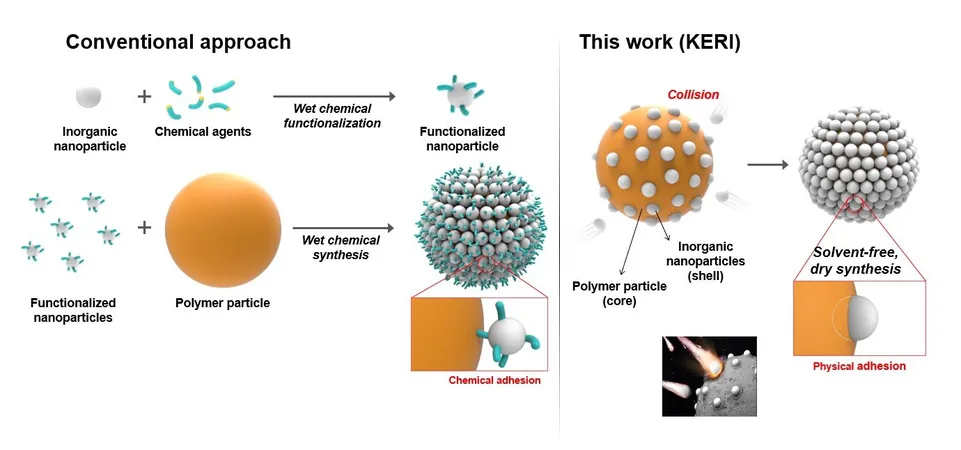
Revolutionizing Material Science: How Nanoparticles Stick Like Toy Blocks!
2025-06-17
Author: Yu
A Groundbreaking Breakthrough in Hybrid Material Synthesis
In an exciting development, Dr. Seunggun Yu and his innovative team at the KERI Insulation Materials Research Center have unveiled a revolutionary method known as "Hybrid Supraparticle Synthesis Technology." This cutting-edge technique allows inorganic nanoparticles to be effortlessly attached to polymer microparticles through simple mechanical collisions, as showcased in the prestigious journal, Advanced Materials.
A Game-Changer for Multiple Industries
This remarkable technology is set to transform various industries, from battery manufacturing and catalyst systems to pharmaceuticals, biotechnology, semiconductor packaging, and electrical insulation materials. By enhancing the synergy between inorganic and polymer materials, this synthesis method promises unparalleled advancements across these fields.
The Flaws of Traditional Methods
Traditionally, integrating different materials relied on complex wet chemical processes. These methods often involved multi-step procedures that can skyrocket costs and raise significant environmental concerns due to harmful solvent usage. Furthermore, they faced limitations in effectively creating strong chemical bonds between diverse materials.
Inspired by Lunar Landscapes
Drawing inspiration from the moon's cratered surface created by asteroid impacts, Dr. Yu’s team developed a revolutionary approach to physically collide particles together. This novel method allows for individual inorganic nanoparticles to attach to the surface of polymer microparticles, forming a robust core-shell structure.
Overcoming Challenges in Implementation
While the concept seems straightforward, achieving stable attachment presented significant challenges. To succeed, the team had to carefully balance numerous factors: particle size ratios, collision velocities, rotational energies, surface energies, and even roughness. Through meticulous optimization, they triumphed by combining various inorganic nanoparticles with microparticles of different sizes and characteristics.
Unveiling the Science Behind the Attachment
This pioneering research not only establishes optimal synthesis conditions but also unearths the previously unknown physical attachment mechanisms, marking a monumental first in the scientific community. Additionally, the team invented a quantitative analysis method to assess nanoparticle attachment levels, surface coverage, and stability, ensuring the durability of the resulting composite particles.
Exceptional Properties and Eco-Friendly Processes
The outcome? Multifunctional, high-reliability composite particles exhibiting remarkable resilience to various environmental challenges. These innovative materials are imbued with essential properties including magnetism, photocatalytic capabilities, and enhanced adsorption functions.
Towards a Sustainable Future in Material Production
Dr. Yu confidently states, "We can easily combine the necessary materials like toy blocks using an eco-friendly, dry process without solvents, paving the way for mass production and commercialization. This technology opens doors to a vast array of attachable materials and boasts high reproducibility, making it accessible for various industries."




 Brasil (PT)
Brasil (PT)
 Canada (EN)
Canada (EN)
 Chile (ES)
Chile (ES)
 Česko (CS)
Česko (CS)
 대한민국 (KO)
대한민국 (KO)
 España (ES)
España (ES)
 France (FR)
France (FR)
 Hong Kong (EN)
Hong Kong (EN)
 Italia (IT)
Italia (IT)
 日本 (JA)
日本 (JA)
 Magyarország (HU)
Magyarország (HU)
 Norge (NO)
Norge (NO)
 Polska (PL)
Polska (PL)
 Schweiz (DE)
Schweiz (DE)
 Singapore (EN)
Singapore (EN)
 Sverige (SV)
Sverige (SV)
 Suomi (FI)
Suomi (FI)
 Türkiye (TR)
Türkiye (TR)
 الإمارات العربية المتحدة (AR)
الإمارات العربية المتحدة (AR)